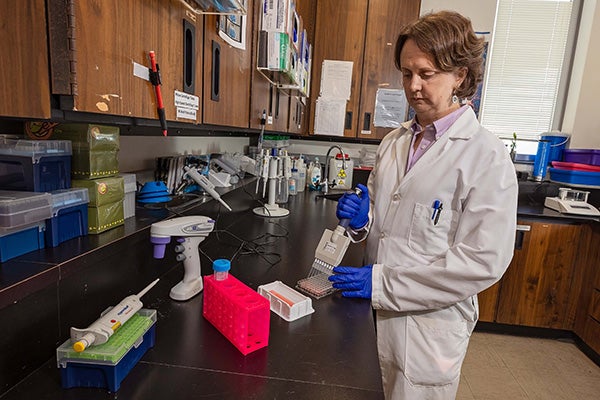ECU researcher lands featured journal cover story
East Carolina University research instructor Tracey Woodlief made the cover of the journal Toxics for her work with the Department of Pharmacology and Toxicology’s DeWitt Lab researching the effects of per- and polyfluoroalkyl substances — also known as PFAS — in the Cape Fear River.
Woodlief was the lead author on the May edition’s cover for her team’s publication “Immunotoxicity of per- and polyfluoroalkyl Substances: Insights into short-chain PFAS exposure.”

East Carolina University research instructor Tracey Woodlief prepares a sample in the lab. Woodlief’s research was featured on the cover of Toxics journal in May for her work research PFAS in the Cape Fear River. (Photo by Cliff Hollis)
The study examined the potential adverse health outcomes of a specific PFAS group found in the eastern North Carolina river system.
This group of PFAS, known as perfluoroalkyl ether acids (PFEAs), has not been studied for its effect on general toxicity and immune health. While earlier research has examined the health effects of long-chain PFAS — substances with six or more carbons — Woodlief’s study is the first of its kind to report the effects of short-chain PFAS.
“New and emerging PFAS are being detected in drinking water sources and in human blood samples from people who drink the water,” Woodlief said. “As there is little to no toxicological data for these new and emerging PFAS, people who have these PFAS in their drinking water should ask what is being done or what can be done to remove these PFAS.”
Woodlief’s study examined whether three PFEAs (perfluoro-2-methoxyacetic acid, PFMOAA; trifluoromethoxy propionic acid, PFMOPrA; and perfluoro-4-methoxybutanioc acid, PFMOBA) produced signs of immunotoxicity.
As part of the study, doses of PFMOAA, PFMOPrA and PFMOBA were administered to male and female mice for 30 consecutive days based on daily body weight. The dosing levels were based on reports of concentrations of these PFEAs in finished drinking water from the Cape Fear River.
The study examined body weight, physical activity, posture and body condition to determine overt toxicological response. Study findings indicate that the doses administered were not overtly toxic.
Results founds that none of the PFEAs at the administered doses affected body weight in male or female subjects used in the study. Additionally, there were no statistical differences in thymus or spleen weights, thymus cell health or thymus T cell subpopulations. There were also no changes in a marker of enzyme activity in the liver, activity of innate immune cell function or adaptive immune function.
However, in male and female subjects given PFMOBA, several statistical changes were seen in the number of B and natural killer (NK) cell subpopulations within the spleen.
“B cells are important cells in the adaptive immune system and are responsible for making and secreting antibodies,” Woodlief said. “They are an integral component of how the body mounts a vaccine response. Natural killer (NK) cells play an important role in the innate immune system and are key in recognizing cancerous cells, for example. Reductions in B and NK cell populations indicate that these compounds have the potential to affect the immune system, but as the changes in these populations were not linked to the immune functions that we measured, it is challenging to interpret what these results mean without looking at additional functions of the immune system.”
The study’s result suggests that due to their shorter carbon chains, the three tested PFEAs may not be as potent as other PFAS at affecting enzyme activity in the liver.
“One assumption that is held about short-chain PFAS is that they have little to no toxicity,” Woodlief said. “However, our findings that certain short-chain PFAS can alter immune cell populations, which are responsible for eliciting an immune response, suggest that these short-chain PFAS have immunotoxic potential.”
Woodlief, who previously served as a postdoctoral scholar in the Brody School of Medicine, said the DeWitt Lab is continuing its work examining how PFAS affect the body.
“I am working on a project funded by the NCSU Center for Human Health and the Environment to ask if PFOA, a well-studied legacy compound that is known to be immunotoxic, can change markers of metabolism,” she said. “My hope is that I can figure out mechanisms of action by which immune system is blunted in response to PFOA exposure. The lab also has several more immunotoxicological studies to perform on additional PFAS found in North Carolina through funding from the NC Policy Collaboratory.”
Related:
Congressional Testimony: ECU researcher testifies in front of Congress on the dangers of PFAS
Harmful Chemicals: ECU immunotoxicity expert encourages regulation of chemicals in everyday products